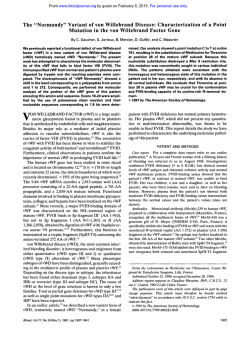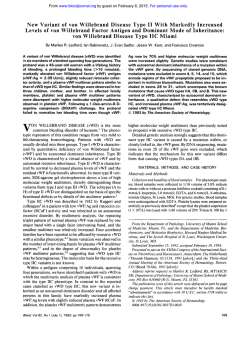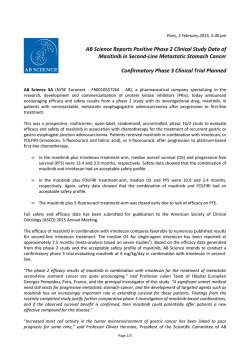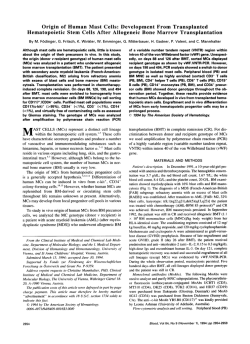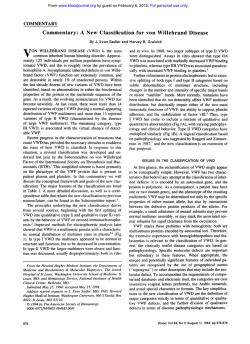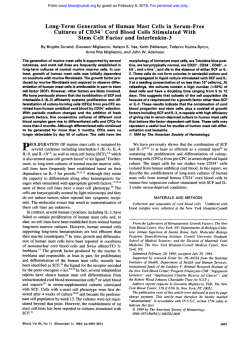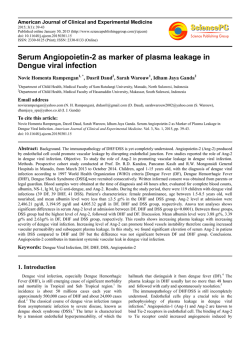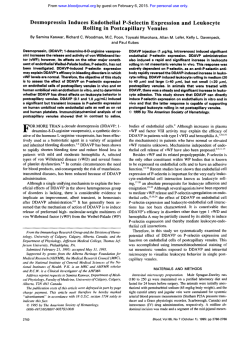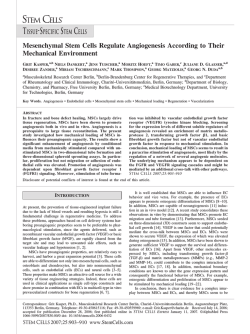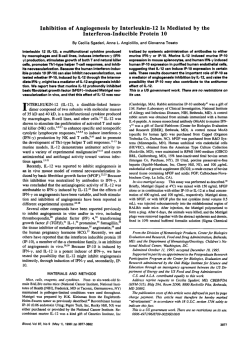
Leakage of von Willebrand Factor and Mast Cell Degranulation in
Leakage of von Willebrand Factor and Mast Cell Degranulation in the Skin of Patients with Systemic Sclerosis Leakage of von Willebrand Factor and Mast Cell Degranulation in the Skin of Patients with Systemic Sclerosis Zygmunt Mackiewicz1,2, Yrjö T Konttinen2, Danutë Povilënaitë1, Ismo Virtanen2 Institute of Experimental and Clinical Medicine, Vilnius, Lithuania 2 Biomedicum University of Helsinki, Finland 1 Immunohistochemical expression of von Willebrand factor (vWF), the number and intensity of mast cell degranulation, and small blood vessel electron microscopical morphology in the group of 9 patients with an established diagnosis of systemic sclerosis (SSc), aged 2954 years (mean, 47.5) was studied. The control group consisted of 10 age-matched subjects free of any systemic disease. All skin biopsies were obtained from the forearm. A coincidence of extensive extravascular vWF leakage, small blood vessel damage, and perivascular mast cell degranulation in the early edematous stage of SSc was found. In the late fibrotic stage of SSc neither vWF leakage nor mast cell degranulation were prominent, if any. In the mid stages of SSc pathogenesis, intensive mast cell degranulation but no vWF leakage were present. Key words: von Willebrand factor, blood vessels, mast cells, systemic sclerosis, skin biopsy INTRODUCTION Vascular involvement in systemic sclerosis (SSc) has been known from the early descriptions of the disease. The disease is characterized by more or less specific microvascular changes such as bushy capillaries, hemorraghes and thrombosis gradually leading to diminished number of capillary blood vessels in affected sites, accompanied by fibrosis in the damaged area. The first target for vascular deterioration in SSc is endothelium (12, 16). SSc patients are in hypercoagulable state with elevated plasma levels of fibrinogen and von Willebrand factor (vWF), defective tissue plasminogen activator release, elevated plasminogen activator inhibitor, enhanced thrombin generation and increased fibrin formation (3). Excessive thrombin acts as a mitogen for fibroblasts, upregulates vWF and plasminogen activator inhibitor, enhances endothelin production by vascular endothelial cells and facilitates fibrin deposition on vessel wall (3, 5, 17). vWF is secreted by endothelial Correspondence to: Zygmunt Mackiewicz, Department of Pathology, Institute of Experimental and Clinical Medicine, Þygimantø 9, LT-2600 Vilnius, Lithuania. E-mail: [email protected] ISSN 13920138. A c t a medica cells constitutively into circulation, but also is deposited in specific storage organelles known as WeibelPalade bodies. The high molecular weight, polyvalent vWF is released by exocytosis upon vascular stimulation, irritation and/or damage (6, 9, 26, 33, 35). There are evidences that mast cells are involved in the development of interstitial edema and in very early stages of SSc pathogenesis (2, 11). The aims of the present study were to asses vascular damage/vWF release into peri- and extravascular space and mast cell degranulation as eventual local pathomechanisms in SSc. PATIENTS AND METHODS Patients and biopsies Nine women patients aged 2954 years (mean, 47.5) were examined clinically before a biopsy was taken. All SSc patients were hospitalized, gave their informed consent and met the criteria established by the American College of Rheumatology for SSc (15, 32). All patients were classified as suffering from a systemic form of scleroderma. Ten control skin sam- L i t u a n i c a . 2002. T. 9, Nr. 4 Zygmunt Mackiewicz, Yrjö T Konttinen, Danutë Povilënaitë, Ismo Virtanen ples were taken from patients in Surgical Department. They patients didnt suffer from any systemic disease. All biopsies were from the forearm skin. One half of the material, intended for immunohistochemical analysis, was fixed in 10% neutral formalin and ethanol, embedded in paraffin and then processed for staining with hematoxilyn-eosin and toluidine blue at pH of 2.0 for the mast cell detection and evaluation. Mast cells were identified by their metachromatic granules and unilobed nuclei. Another half of every biopsy was fixed in 2.5% glutaraldehyde followed by 2% osmium tetroxide, and embedded in Epons for further electron microscopic analysis. Imunohistochemistry The primary antibodies used were serum protein absorbed rabbit anti-human vWF IgG (1:500, Dakopats A/S, Glostrup, Denmark). Paraffin sections (5 µm) were mounted on DAKO Capillary slides (TechMate DAKO, Glostrup, Denmark), deparaffinized in xylene and rehydrated in a graded ethanol series and 10 mM phosphate-buffered, 0.9 M saline, pH 7.4 (PBS). For antigen retrieval the slides were pretreated with 0.4% pepsin in 1N HCl at +37 °C for 30 minutes. Then the slides were washed and stained automatically in a staining robot by the following protocol: 1) the primary antibody, diluted with DAKO ChemMate antibody diluent, for 30 minutes; 2) secondary antibody containing biotinylated goat anti-rabbit IgG for 30 minutes; 3) peroxidase block for 30 minutes; 4) peroxidase-conjugated streptavidin 3 times for 3 minutes; 5) HRP Substrate Buffer, and finally 6) substrate working solution containing 3,3-diaminobenzidine tetrahydrochloride (ChemMate Detection Kit) for 5 minutes. Between each step, the sections were washed with DAKO ChemMate washing buffers three times and dried in absorbent pads. After staining the sections were removed from the robot, counterstained with hematoxylin or left without counterstaining, washed, dehydrated in ethanol series, cleared in xylene and mounted in synthetic mounting medium (Diatex, Beckers Industrifärg AB, Märsta, Sweden) Replacement of the primary antibody with normal rabbit IgG in a corresponding dilution was used as negative staining control. All incubations were performed at +22 °C. Microscopic examination Microscopic assessment was done using a low lightcharge screen mounted with a 12-bit PC digital image camera (SensiCam, Kelheim, Germany) on a Leitz Diaplan light microscope (Wetzler, Germany). The whole (papillary and reticular) derma section areas were analyzed. Diffusion of vWF from the blood vessels into extracellular/perivascular space and perivascular mast cell degranulation were scored as none (0), mild (+), moderate (++), or strong (+++). The score evaluation was done by two microscopists independently. Ultrathin sections were prepared with LKB ultratome, stained with saturated uranyl acetate and lead citrate, and examined in electron microscope JEM 100 B. RESULTS Histological analysis of SSc biopsies disclosed the earliest pathological changes in the skin. Perivascular edema was an early feature. With progression of the pathogenesis, an inflammatory cell infiltration into the dermis and platelet aggregation within vessels developped. Further clinical progression was associated with loss of adnexae, vascular effacement and increasing dermal fibrosis. Immunotopochemical detection of vWF showed its expression in the skin blood vessel network which corresponded to the network revealed by the standard reference stainings. The degree of vWF expression in the particular vessels and particular areas could significantly differ. In the early stage of SSc pathogenesis, the atypical forms of papillary layer vessels occasionally were observed (Fig. 1a). In some Fig. 1. Expression of vWF in skin in systemic sclerosis: a vWF in bushy capillaries (arrows); b extensive extravasation of vWF (arrows). Counterstained with hematoxylin; c reduction of capillary network (arrows). Counterstained by hematoxylin; d vWF in nornal control. Original magnification: ×250. Abbreviation: ep epidermium Leakage of von Willebrand Factor and Mast Cell Degranulation in the Skin of Patients with Systemic Sclerosis Table. vWF leakage and mast cell degranulation in SSc patients skin Patient Age (years) Duration of disease (years) vWF extravasation Perivascular mast cell degranulation 1 2 3 4 5 6 7 8 9 52 54 53 54 29 49 45 43 52 2 1 4 15 1 21 6 8 3 + ++ 0 0 ++ 0 0 0 ++ + ++ + 0 +++ 0 ++ + ++ Vascular damages Endothelial Endothelial Endothelial Fibrosis Endothelial Fibrosis Necrobiosis Fibrosis Endothelial edema edema shrinkage edema edema Score value: 0 none, + mild, ++ moderate, +++ strong. Fig. 2. Ultrastructural changes in SSc skin: a, b mast cells and degenerating nerves close by deteriorating blood vessel. ×3000; c fibrosing blood vessel. ×3000; d edematous blood vessel. ×3000; e mast cell granules among fibrous tissue. ×6000; f fibrin and mast cell granules in the derma. ×8000. Abbreviations: bv blood vessel, coll collagen fibers, fib fibrin, mc mast cell granules, ne nerve fibers areas more or less evident leakage of vWF into extracellular matrix was found (Table, Fig. 1b). In the advanced fibrotic stage of SSc when the blood vessel network was dramatically reduced, no vWF leakage into the perivascular interstitial matrix was detectable (Fig. 1c), and the vWF staining was usually restricted to endothelial cells. No vWF leakage was found in the healthy skin from control subjects (Fig. 1d). We have shown an increased mast cell number and intensity of their degranulation in SSc patients (Table) with the early indurative phase of the disease. It was especially remarkable in the papillary dermis. In the immediate proximity to adventitia, extensive mast cell degranulation and fibrin deposition was found next to small blood vessels both in papillary and reticular layers of the skin (Fig. 2e 2f). In patients with the late fibrotic phase of SSc, the mast cell number and degranulation decreased as compared to the initial phase of the disease and the controls. At this stage the papillary layer was filled with homogeneous collagen bundles. A change in mast cell number and the intensity of degranulation reflected a change in interstitial collagen bundles in the papillary layer. The ultrastructural analysis of SSc skin biopsies, even in the early stages of the disease, revealed a serious damage in small blood vessels and perivascular areas (Fig. 2a2b). It comprised edema, mast cell infiltration and degranulation, nerve fiber dystrophy, and mild interstitial fibrosis. Blood vessel walls underwent necrobiosis and dystrophy (Fig. 2c 2d), the lumina gradually narrowed. The endothelial cells were shrunk. In the late stages of SSc small blood vessel occlusion, atresia and a progressing tissue fibrosis dominated. DISCUSSION Angiogenesis and microvascular remodeling are the known features of chronic inflammatory diseases. Angiogenesis is the growth of new blood vessels from existing ones, whereas microvascular remodeling involves structural alterations (usually enlargement) of arterioles, capillaries or venules, without the formation of new vessels (20). In the present study, in patients with the initial stage of SSc we found signs of atypical capillary proliferation (bushy capillaries). ! Zygmunt Mackiewicz, Yrjö T Konttinen, Danutë Povilënaitë, Ismo Virtanen This is in agreement with experimental observations (27) that SSc initially can evoke angiogenesis. In the late stages of SSc we found only blood vessel deterioration and atresia, no longer angiogenesis. In surrounding vessel-free tissues dominated firm fibrosis. Other, typical of SSc blood vessel damages (24, 33) were also found in our study. In normal vessels, histamine, bradykinin, substance P, and 5-hydroxytryptamine (5-HT) cause plasma leakage through the formation of focal gaps among endothelial cells [18]. Many substances are known to cause plasma leakage by increasing vascular permeability but only few have the opposite effect. B2-Adrenergic agonists are among them (1, 14). Endothelial fenestrae, transcytotic vesicles, vesico-vacuolar organelles (VVOs), and monolayer defects may contribute to increased plasma extravasation in pathological conditions accompanied by angiogenesis and microvascular remodeling (7, 10, 28). Newly formed and remodeled blood vessels typically have abnormalities in endothelial barrier function (8, 13). Several factors are likely to participate in the leakiness of remodeled blood vessels. An increase in endothelial permeability resulting from focal separations ~400 nm (the largest particles to pass across being < 2 µm in diameter) between endothelial cells is likely to be involved (4, 19). Also the enlargement of arterioles may lower the upstream resistance and increase the transmural driving force for leakage. Impaired clearance of extravasated proteins via lymphatics could be another factor (our unpublished data on vascular endothelium growth factor receptors, VEGFR, 20). In our observations, the SSc patients in the early stage of disease were characterized by a severe or moderate release of endothelial vWF into the perivascular and/or interstitial matrix, whereas normal control skin biopsies were characterized by no vWF diffusion or leakage. No vWF expression was found in negative control samples. Many observations indicate an increase of vWF in circulation in SSc patients (3, 5, 17, 29). Extravasation of vWF may contribute to pathogenesis of chronic inflammation (6, 23, 31, 25). Abnormalities in the vascular remodeling are potentially reversible by therapeutic intervention (20). Mast cells in scleroderma have been discussed for past decades without any definite conclusion. It was shown (2, 22) that in SSc skin in the edematous stage in both papillary and reticular dermis mast cell density was significantly increased as compared with normal skin. It was found that mast cells were involved in the development of interstitial edema. But in the sclerotic stage characterized by homogenization of collagen bundles, skin mast cell density was significantly decreased. This is not a statement " of all authors (30). There is no comprehensive analysis in the literature concerning the role of mast cells in SSc, probably because of their usual association with immediate hypersensitivity phenomena, graft-versus-host reaction, and very broad spectrum of physiological effects. In normal subjects mast cells are unevenly distributed around dermal appendages, blood vessels, and nerves. Cutaneous mast cell density is highly variable among persons and is known to decrease with age. It is conceivable that mast cells have direct effects on fibroblast physiology. In humans, mast cells are located predominantly in the skin, lungs, and gastrointestinal tract, the organs most seriously affected by the sclerotic process of SSc. The mere presence of mast cells alone, however, is not sufficient for development of fibrosis (21). In our SSc biopsy specimens, in the early stages of disease we found a coincidence of vWF leakage and extensive perivascular mast cell degranulation. The specific mechanism of the coincidence remains to be elucidated. References 1. Advenier C, Qian Y, Koune JDL, Molimard M, Candenas ML, Naline E. Formoterol and salbutamol inhibit bradykinin- and histamine-induced airway microvascular leakage in guinea-pig. Br J Pharmacol 1992; 105: 7928. 2. Akimoto S, Ishikawa O, Igarashi Y, Kurosawa M, Miyachi Y. Dermal mast cells in scleroderma: their skin density, tryptase/chymase phenotypes and degranulation. Br J Dermatol 1998; 138: 399406. 3. Ames PR, Lupoli S, Alves J, Atsume T, Edwards C, Iannaccone L, Khamashta MA et al. The coagulation/ fibrinolysis balance in systemic sclerosis: evidence for a haematological stress syndrome. Br J Rheumatol 1997; 36: 104550. 4. Baluk P, Hirata A, Thurston G, Fujiwara T, Neal CR, Michel CC, McDonald DM. Endothelial gaps: time cours of formation and closure in inflamed venules of rats. Am J Physiol 1997; 172: L15570. 5. Blann AD, Sheran TP, Emery P. von Willebrand factor: increased levels are related to poor prognosis in systemic sclerosis and not to tissue autoantibodies. Br J Biomed Sci 1997; 54: 59. 6. Èeponis A, Konttinen YT, Mackevicius Z, Solovieva SA, Hukkanen M, Tamulaitienë M, Matulis A, Santavirta S. Aberrant vascularity and von Willebrand factor distribution in inflamed synovial membrane. J Rheumatol 1996; 23: 18806. 7. Dvorak AM, Kohn S, Morgan ES, Fox P, Nagy JA, Dvorak HF. The vesiculo-vacuolar organelle (VVO): a distinct endothelial cell structure that provides a transcellular pathway for macromolecular extravasation. J Leukoc Biol 1996; 59: 10015. 8. Dvorak HF, Brown LF, Detmar M, Dvorak AM. Vascular permeability factor/vascular endothelial growth factor, microvascular hypermermeability, and angiogenesis. Am J Pathol 1995; 146: 102939. Leakage of von Willebrand Factor and Mast Cell Degranulation in the Skin of Patients with Systemic Sclerosis 9. Galbusera M, Zoja C, Donadelli R, Paris S, Morigi M, Benigni A, Figliuzzi M et al. Fluid shear stress modulates von Willebrand factor release from human vascular endothelium. Blood 1997; 90: 155864. 10. Hashizume H, Baluk P, Morikawa S, McLean JW, Thurston G, Roberge S, Jain RK, McDonalds DM. Openings between defective endothelial cells explain tumor vessel leakiness. Am J Pathol 2000; 156: 136380. 11. Hebbar M, Gillot JM, Hachulla E, Lassalle P, Hatron PY, Devulder B, Janin A. Early expression of E-selectin, tumor necrosis factor alpha, and mast cell infiltration in the salivary glands of patients with systemic sclerosis. Arthritis Rheum 1996; 39: 11615. 12. Herron GS, Romero LI. Vascular abnormalities in scleroderma. Semin Cutan Med Surg 1998; 17: 127. 13. Hobbs SK, Monsky WL, Yuan F, Roberts WG, Griffith L, Torchilin VP, Jain RK. Regulation of transport pathways in tumor vessels: role of tumor type and microenvironment. Proc Natl Acad Sci USA 1998; 95: 460712. 14. Ishizaka T, Ishizaka K, Orange RP, Austen KF. Pharmacologic inhibition of the antigen-induced release of histamine and slow reacting substance of anaphylaxis (SRS-A) from monkey lung tissues mediated by human IgE. J Immunol 1971; 106: 126773. 15. LeRoy EC, Black C, Fleischmajer R, Jabùoñska S, Krieg T, Medsger TA et al. Scleroderma (systemic sclerosis): classification, subjects and pathogenesis. J Rheumatol 1988; 15: 2024. 16. Mackiewicz Z, Tamulaitienë M, Kirdaitë G, Woolley D, Jeziorska M, Dàbroú W. Early vascular damages in systemic sclerosis. Acta med Lituanica 1999; 6: 36. 17. Marzano AV, Federici AB, Gasparini G, Mannucci PM, Caputo R, Berti E. Coagulation Factor XIII, endothelial damage and systemic sclerosis. Eur J Dermatol 2000; 10: 147. 18. McDonald DM. Endothelial gaps and permeability of venules in rat tracheas exposed to inflammatory stimuli. Am J Physiol 1994; 266: L6183. 19. McDonald DM, Thurston G, Baluk P. Endothelial gaps as sites for plasma leakage in inflammation. Microcirculation 1999; 6: 722. 20. McDonald DM. Angiogenesis and remodeling of airway vasculature in chronic inflammation. Am J Respir Crit Care Med 2001; 164: 53945. 21. Mihm MC, Clark WH, Reed RJ, Caruso MG. Mast cell infiltrates of the skin and the mastocytosis syndrome. Hum Pathol 1973; 4: 2319. 22. Nishioka K, Kobayashi Y, Katayama I, Takijiri C. Mast cell numbers in diffuse scleroderma. Arch Dermatol 1987; 123: 2058. 23. Preissner KT, Potzsch B. Vessel wall-dependent metabolic pathway of the adhesive proteins, von Willebrand factor and vitronectin. Histol Histopathol 1995; 10: 23951. 24. Prescott RJ, Freemont AJ, Jones CJ, Hoyland J, Fielding P. Sequential dermal microvascular and perivascular changes in the development of scleroderma. J Pathol 1992; 166: 25563. 25. Rand JH, Glanville RW, Wu XX, Ross JM, Zangari M, Gordon RE, Schwartz E, Potter BJ. The significance of subendothelial von Willebrand factor. Thromb Haemost 1997; 78: 44550. 26. Reinders JH, de Groot PG, Sixma JJ, von Mourik JA. Storage and secretion of von Willebrand factor by endothelial cells. Haemostasis 1988; 18: 24661. 27. Ribatti D, Cantatore FP, Vacca A, DAmore M, Ria R, Roncali L, Pipitone V. Systemic sclerosis stimulates angiogenesis in the chick embryo chorioallantoic membrane. Clin Rheumatol 1998; 17: 11520. 28. Roberts WG, Palade GE. Neovasculature induced by vascular endothelial growth factor is fenestrated. Cancer Res 1997; 57: 76572. 29. Scheja A, Akesson A, Geborek P, Wildt M, Wollheim CB, Wollheim FA, Vischer UM. von Willebrand factor propeptide as a marker of disease activity in systemic sclerosis (scleroderma). Arthritis Res 2001; 3: 17882. 30. Seibold JR, Giorno RC, Claman HN. Dermal mast cell degranulation in systemic sclerosis. Arthritis Rheum 1990; 33: 17029. 31. Sporn LA, Marder VJ, Wagner DD. von Willebrand factor released from WeibelPalade bodies binds more avidly to extracellular matrix than secreted constitutively. Blood 1987; 69: 15314. 32. Subcommittee for Scleroderma Criteria of the American Rheumatism Association Diagnostic and Therapeutic Criteria Committee. Preliminary criteria for the classification of systemic sclerosis (scleroderma). Arthritis Rheum 1980; 23: 58190. 33. Vapaatalo H, Mervaala E. Clinically important factors influencing endothelial function. Med Sci Monit. 2001; 7: 107585. 34. Von Bierbrauner A, Barth P, Willert J, Baerwald C, Mennel HG, Schmidt JA. Electron microscopy and capillaroscopically guided nailfold biopsy in connective tissue diseases: detection of ultrastructural changes of the microcirculatory vessels. Br J Rheumatol 1998; 37: 12728. 35. Wagner DD. Cell biology of von Willebrand factor. Annu Rev Cell Biol 1990; 6: 21746. Z. Mackiewicz, Y. T. Konttinen, D. Povilënaitë, I. Virtanen VON WILLEBRANDO VEIKSNIO PRASISUNKIMAS IR TUKLIØJØ LÀSTELIØ DEGRANULIAVIMASIS SISTEMINE SKLEROZE SERGANÈIØJØ ODOJE Santrauka Iðtyrëme devyniø ligoniø, serganèiø sistemine skleroze, odos bioptatus. Imunohistochemiðkai ir elektroniniu mikroskopu iðanalizavome von Willebrando veiksnio ekspresijà, smulkiøjø kraujagysliø morfologijà ir tukliøjø làsteliø degranuliavimàsi. Kontrolinæ grupæ sudarë deðimt atitinkamo amþiaus þmoniø, neserganèiø sistemine skleroze. Nustatëme daþnà ekstravaskuliná von Willebrando veiksnio prasisunkimo, smulkiøjø kraujagysliø paþeidimo ir tukliøjø làsteliø degranuliavimosi sutapimà ankstyvojoje sisteminës sklerozës stadijoje. Vëlyvojoje fibrozinëje sisteminës sklerozës stadijoje jau neaptikome nei intensyvaus von Willebrando veiksnio prasisunkimo ið kraujagysliø sieneliø ir spindþiø á ekstravazaliná tarpà, nei tukliøjø làsteliø degranuliavimosi. Taip pat pastebëta dalies smulkiøjø odos kraujagysliø atrezija. Analizës rezultatai parodë ankstyvà kraujagysliø paþeidimà sisteminës sklerozës patogenezëje. Raktaþodþiai: sisteminë sklerozë, kraujagyslës, von Willebrando veiksnys, tukliosios làstelës, oda #
© Copyright 2025
